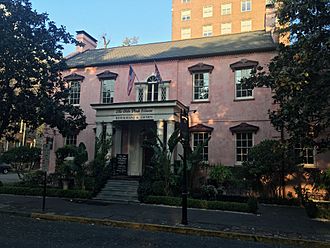The Olde Pink House facts for kids
Quick facts for kids The Olde Pink House |
|
|---|---|
|
The Pink House
|
|
 |
|

The Olde Pink House in 2017
|
|
| Former names | Habersham House |
| General information | |
| Architectural style | Georgian |
| Location | Reynolds Square, Savannah, Georgia, United States |
| Address | 23 Abercorn Street |
| Coordinates | 32°04′47″N 81°05′23″W / 32.07967°N 81.08984°W |
| Construction started | 1771 |
| Completed | 1789 |
| Owner | Donna Moeckel |
| Technical details | |
| Floor count | 3 |
| Floor area | ~16,000 sq. ft |
| Design and construction | |
| Architect | Joseph Clay (original); Mark P. Finlay Architects (2006 expansion) |
The Olde Pink House is a famous restaurant and tavern in Savannah, Georgia, United States. People also call it The Pink House. Long ago, it was known as Habersham House.
This historic building is on Abercorn Street, near Reynolds Square. It was first built in 1771. A special feature of the house is a large window above the main entrance, called a Palladian window. This window has three parts, with a tall arch in the middle.
The Olde Pink House is right across the street from another old building, the Oliver Sturges House. That house was built 24 years later.
Contents
A Look Back: The History of the Pink House
The Olde Pink House has a long and interesting past. It has been many things over the years, from a family home to a bank and now a popular restaurant.
The Early Years: 1700s
The building we see today was finished in 1789. It was first called Habersham House. Its owner was James Habersham, Jr., an important person in early Savannah. He helped manage cotton businesses and was part of a founding family. James Habersham, Jr. lived in the house until he passed away in 1799.
The land for the house was originally given by the British Crown. The house was lucky to survive a big fire in Savannah in 1796. That fire destroyed many other buildings in the city.
Becoming a Bank: 1800s
In 1812, the house became Planters Bank. This was the very first bank in Georgia! Around this time, a new front porch, called a portico, was added. It had strong columns that supported the roof. An extra section was also built on the north side of the house.
New Uses and Restoration: 1900s
After the American Civil War, the house had many different owners and purposes. It was an architect's office, a lawyer's office, and even a bookstore. From 1930 to 1943, it was a tea room called Alida Harper Fowlkes' Georgian Tea Room.
In 1968, a man named Jim Williams bought the building and started to fix it up. He also owned another famous Savannah house, Mercer House.
In 1970, Herschel McCallar, Jr. and Jeffrey Keith bought the house. They spent a year carefully restoring it. They even lifted the whole building to fix its foundation! This made the old doorways and moldings fit perfectly again. They also found two old fireplaces in the basement. These were once the original kitchen in the 1700s and are now part of the bar.
They also changed the staircases to bring back the original 18th-century style. They added new plumbing, electricity, and a new kitchen. Jeffrey Keith also opened an antique store on the second floor. They traveled to England to buy many old antiques and paintings that you can still see in the restaurant today. The restaurant officially opened in 1971.
In 1992, Keith sold the building to William and Elizabeth Balish. They kept the beautiful restoration that McCallar and Keith had done. Today, Donna Moeckel, the Balishes' daughter, is the owner.
Modern Times: 2000s
In 2006, a new bar called Arches Bar was added to the south side of the building. There is also a cozy cellar tavern called Planters Tavern. This tavern even has a special wine vault for private dinners. In total, the restaurant has thirteen different dining rooms.
In December 2018, a fire started in an upstairs ballroom. The building had to close for four months for repairs. It reopened, continuing its long history as a beloved Savannah spot.
A Similar House
Did you know there's a house that looks almost exactly like The Olde Pink House? It was built in 1928 at 102 East Gaston Street, near Forsyth Park.
Images for kids








